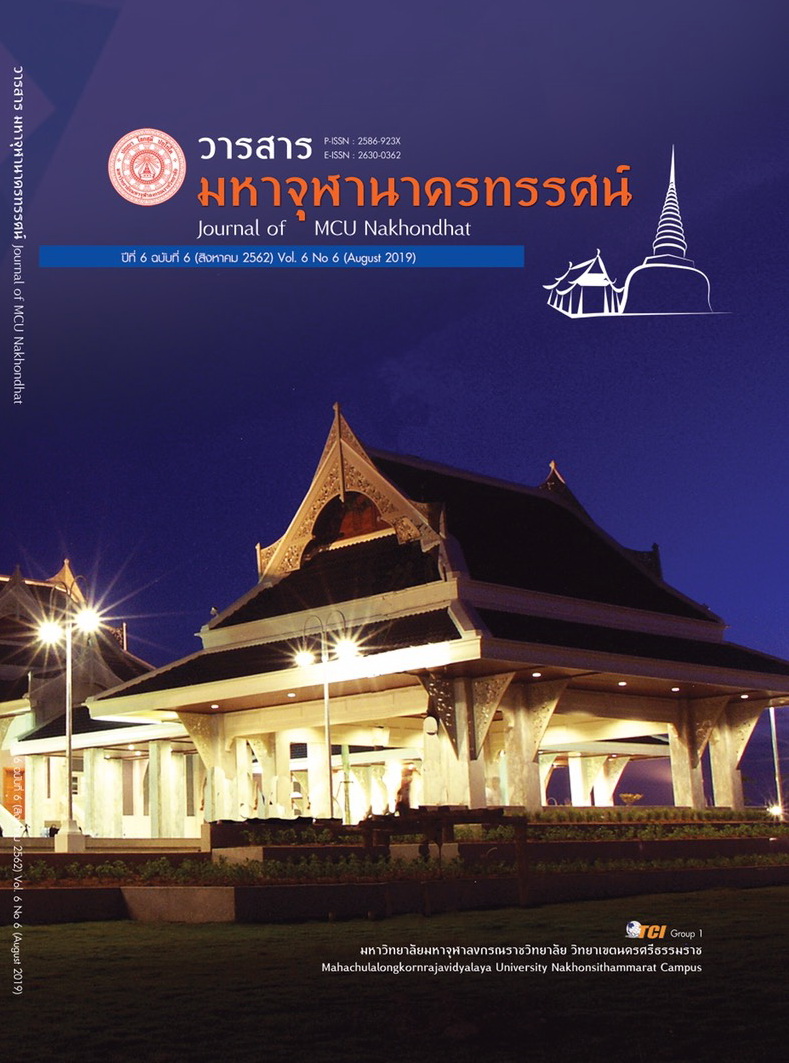PERSONNEL MANAGEMENT ACCORDING TO BUDDHIST EDUCATIONAL ADMINISTRATION OF SCHOOL ADMINISTRATORS UNDER THE OFFICE OF SECONDARY EDUCATIONAL SERVICE AREA
Main Article Content
Abstract
The objectives of this research were; 1) to study the state of personnel management according to Buddhist Educational Administration of school administrators under the Office of Secondary Educational Service Area, 2) to develop personnel management according to Buddhist Educational Administration, and 3) to propose a guideline of personnel management according to Buddhist Educational Administration. The data were collected by questionnaires from 320 samples, by in-depth interviews with 8 key-informants, and focus group discussions with 9 key-informants.
The results of the study found that:
The state of personnel management according to Buddhist Educational Administration of school administrators under the Office of Secondary Educational Service Area was at a high level overall. The highest level was on workforce planning, followed by job assignment. The development of personnel management according to Buddhist Educational Administration of school administrators under the Office of Secondary Educational Service Area had 4 steps as follows; 1. To analyze the data based on each problem, 2. To set up operation plan, 3. To operate along the set plan, and 4. To monitor and evaluate the operation. The development process of personnel management was integrated with the principles of the ruler, good governance, Brahmavihara Dhamma, The Four Noble Truths, and Development or Bhāvanā. The proposed guideline of personnel management according to Buddhist Educational Administration of school administrators under the Office of Secondary Educational Service Area was as follows; 1) In personnel planning, there should be meetings for plan setting, 2) In Personnel recruitment, 3) In personnel development, there should be development training plans, 4) In personnel maintenance, suitable welfare should be provided to personnel, and 5) Work performance evaluation, monitoring and evaluating the work performance should be based on the principles of the Threefold Training.
Article Details
References
ปรัชญา ภัทรกำจร. (2546). การศึกษาการบริหารงานบุคคลในสถานศึกษาขั้นพื้นฐาน: จังหวัดฉะเชิงเทรา. ใน วิทยานิพนธ์ครุศาสตรมหาบัณฑิต สาขาการบริหารการศึกษา. มหาวิทยาลัยราชภัฏราชนครินทร์.
พระนิรันดร์ สุทฺธิเมตฺติโก. (2552). การบริหารงานบุคคลในโรงเรียนมัธยมศึกษา เขตบางกอกน้อย สำนักงานเขตพื้นที่การศึกษากรุงเทพมหานคร เขต 3. ใน วิทยานิพนธ์พุทธศาสตรมหาบัณฑิต สาขาบริหารการศึกษา. มหาวิทยาลัยมหาจุฬาลงกรณราชวิทยาลัย.
ลิขิตา เฉลิมพลโยธิน. (2561). อิทธิพลของคุณลักษณะงานและคุณภาพชีวิตในการทำงานที่มีต่อการบริการที่เป็นเลิศผ่านความผูกพันในอาชีพของพนักงานโรงแรมในอำเภอหัวหิน. วารสารวิชาการมหาวิทยาลัยธนบุรี, 12(29), 241-253.
วิไลวรรณ ยะสนธ์. (2552). การบริหารงานบุคลากร โรงเรียนราชประชานุเคราะห์ ภายหลังการย้ายไป สังกัดสำนักบริหารงานการศึกษาพิเศษ. ใน วิทยานิพนธ์ศึกษาศาสตรมหาบัณฑิต สาขาการบริหารการศึกษา. มหาวิทยาลัยเชียงใหม่.
สำนักงานคณะกรรมการการศึกษาแห่งชาติ. (2540). แผนพัฒนาการศึกษาแห่งชาติ ฉบับที่ 8. กรุงเทพมหานคร: สำนักงานคณะกรรมการการศึกษาแห่งชาติ.


